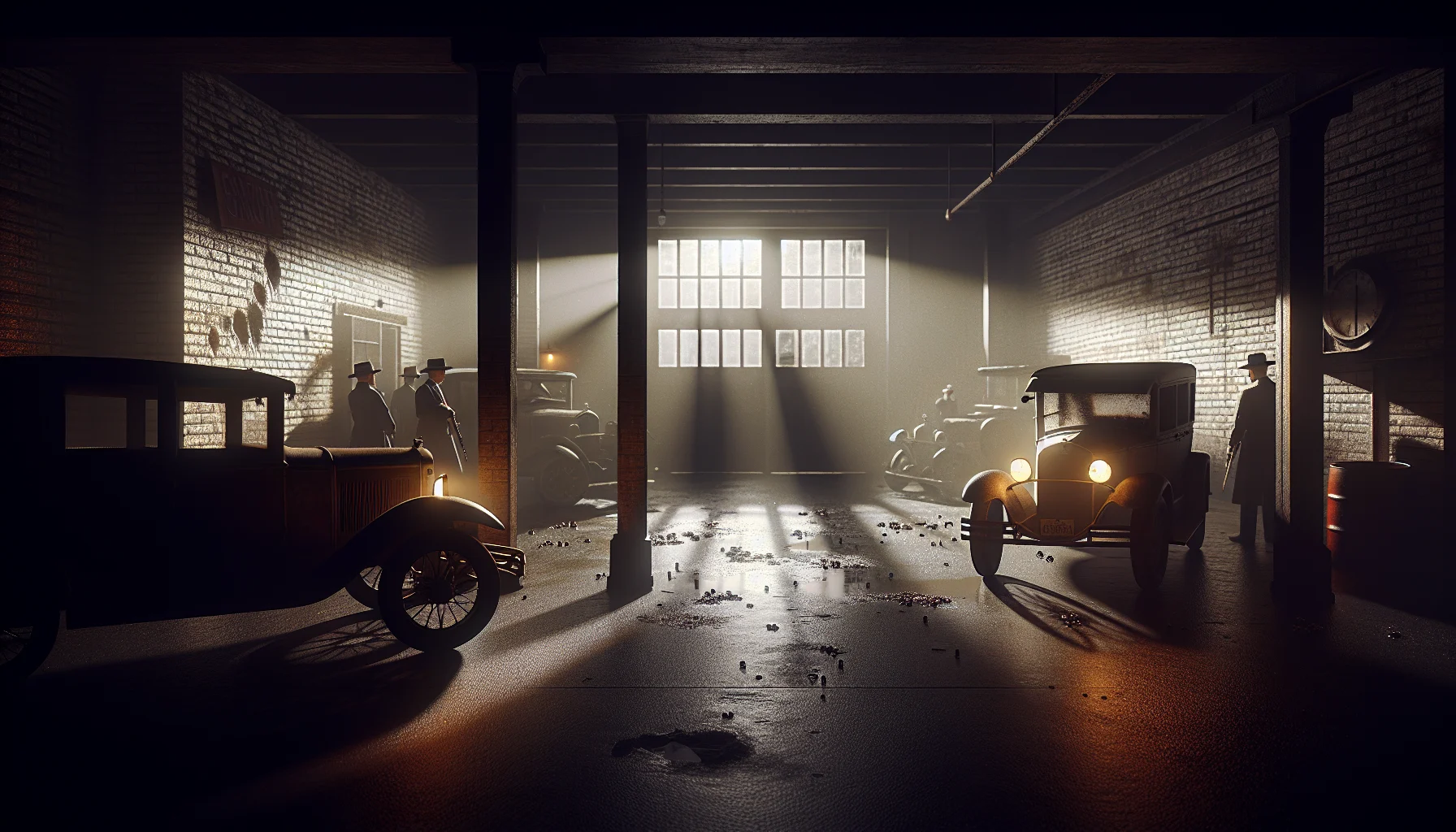
The Saint Valentine's Day Massacre
by: The Calamity Calendar Team
February 14, 1929
Prelude to the Massacre: Brewing Rivalries in Prohibition Chicago
In the swirling winds of February, the atmosphere in Chicago was thick with tension. The city, already notorious for its hustle and grit, was quickly becoming ground zero for a brutal battle of dominance. The chessboard was the illegal liquor trade, a lucrative venture born from the Prohibition laws that banned the sale and distribution of alcohol. As fortunes soared for some, rivalries became emboldened, setting the stage for an inevitable showdown.
At the helm of this underworld were two formidable contenders: Al Capone, the cunning boss of the Italian South Side gang, and his fierce adversary, George "Bugs" Moran, leader of the North Side Gang. Their feud had its roots in an unyielding struggle for control over Chicago's illicit economy. Capone was already a household name, his infamy matched only by his extravagant tastes and ruthless efficiency. His ambition was unparalleled, stretching beyond the speakeasies' flickering neon lights to encompass every facet of the trade.
Moran, on the other hand, was nothing short of tenacious. Himself a force within Chicago's Irish underworld, Moran was a thorn in Capone's side, consistently encroaching on territories that Capone viewed as rightfully his. This clash was not just business—it was deeply personal, and the city braced for what felt like an inevitable explosion of violence.
February 14, 1929: The Piper Paid in Blood
On the morning of February 14, 1929, a chill lingered in the air at 2122 North Clark Street. Inside the SMC Cartage Co. garage, seven members of Bugs Moran's North Side Gang were gathered. These men, hardened and wily, were awaiting a shipment of illegal liquor that promised to bolster their standings. Instead, they walked into a trap that would mark one of the bloodiest moments in mob history.
Shortly after 10:30 AM, the crunch of tires on gravel announced the arrival of two cars outside the garage. From the vehicles emerged four figures—two clad in police uniforms, two in civilian clothing. The deception was deliberate and effective; the men inside the garage believed it was a routine police inspection. After all, such raids were not uncommon in the haze of Prohibition Chicago.
With demands and gestures, the "officers" lined the seven men up against the wall. A semblance of authority cloaked their true intentions. And in mere minutes, the scene transformed from mock law enforcement to merciless annihilation. The fake officers signaled their accomplices, and the air was punctured by the deafening roars of submachine guns and shotguns.
Thanks for subscribing!
When the lead storm ceased, the floor was smeared crimson, and the garage reverberated with a hollow silence. Seven bodies lay there, struck down with ruthless precision—key figures such as Albert Kachellek, known in the gritty alleys as James Clark, lay amongst them.
The Ripples of Violence: Reactions and Speculations
The nation was stunned. News of the massacre spread like wildfire, peeling back the curtain that concealed Chicago's violent underbelly. Headlines screamed of betrayal and death; the public, once captivated by tales of mob glamour, suddenly found themselves engulfed in its raw brutality.
Despite targeting Moran, the elusive gang leader narrowly escaped the bloody culling, having left the scene mere moments before the slaughter unfolded. This stroke of fate saved his life but did little to alleviate his rival’s intentions. The massacre turned the spotlight on the impotence of law enforcement against organized crime.
Within the corridors of power, the event provoked waves of criticism and demands for stricter enforcement. Aldermen and officials decried the spectacle. It intensified efforts to take down the operatives, pulling mob figures further into the fray. Yet, in a bitter twist of irony, the very law enforcers seemed as awestruck and incapacitated as the public they vowed to protect.
Tangible Aftereffects: The Devouring Shadow of Crime
In the massacre’s immediate aftermath, the decimated garage stood as a grim testament to unlawful ambition. The scenes of bloodshed left indelible marks not just on brick and concrete but on the psyche of a city. Though the wider economic impact remains uncharted in exact terms, city authorities grappled with an overwhelming imperative to reel in the anarchy that had gone unchecked for too long.
Public sentiment decisively turned, prompting federal agents and local police to adopt aggressive postures against the scourge of gangs and bootleggers. Large-scale investigations unfolded, yet prosecutions remained elusive. No verifiable accounts linked Capone directly to the orchestrations despite widespread belief in his masterminded role.
Years progressed, yet clues to the identities of those who pulled the triggers remained chillingly absent from files and testimonials. Despite this, the legacy was cogent and observable—the massacre's aftermath ensured a concerted push toward dismantling organized crime's stronghold in American society.
Legacy of Infamy: The Case Unresolved
The Saint Valentine’s Day Massacre, in its brutality and meticulous execution, left an indelible mark on history—a stark illustration of the ferocity infused within the underworld. Gangland legends and would-be historians tirelessly dissect the event, striving to piece together whispers and shadows of truth from memories long buried.
Al Capone's legacy was indeed sealed—not through the blood spilled in that garage, but through eventual tax evasion charges in 1931, a testament to the intricate dance of justice. His removal signaled the dissolution of the untouchable aura once draped over such figures.
To historians and crime enthusiasts alike, this massacre continues to evoke chilling intrigue. It’s a narrative framed by enigmatic motives and shadowy characters, a paradox of terror and fascination—forever etched into the timeline of Prohibition Chicago’s dark past.
Stay in the Loop!
Become a Calamity Insider and get exclusive Calamity Calendar updates delivered straight to your inbox.
Thanks! You're now subscribed.